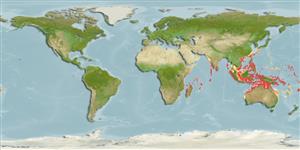>
Gobiiformes (Gobies) >
Gobiidae (Gobies) > Gobiinae
Etymology: Trimma: Greek, trimma, -atos = something crushed (Ref. 45335); annosum: Named in allusion to the plain grey cheek of the species, which is perhaps reminiscent of that class of elderly hirsute human males sometimes referred to as 'greybeards' (Ref. 49832).
More on author: Winterbottom.
Environment: milieu / climate zone / depth range / distribution range
นิเวศวิทยา
เกี่ยวกับทะเล,น้ำเค็ม เกี่ยวกับหินโสโครก; ระดับความลึก 1 - 60 m (Ref. 100726). Tropical
Indo-West Pacific: Maldives and India to Papua New Guinea.
ขนาด / น้ำหนัก / Age
Maturity: Lm ? range ? - ? cm
Max length : 2.8 cm SL เพศผู้/กระเทย; (Ref. 100726)
Short description
เครื่องมือที่ใช้ในการแยกชนิดสัตว์,สิ่งมีชีวิตออกจากกัน | สัณฐานวิทยา | ความยาวต่างๆ
เงี่ยงครีบหลัง (รวม) : 7; ก้านครีบอ่อนที่หาง (รวม) : 8; เงี่ยงครีบก้น: 1; ก้านครีบอ่อนที่ก้น: 8. This species is distinguished by the following characters: a shallow concave bony interorbital about half pupil-diameter in width; predorsal is completely covered with ctenoid scales, no naked patches, a large scale above and between the end of the eyes above the posterior half of the pupil; cheek no scales; operculum often with a single large ctenoid scale dorsally, often followed by a smaller cycloid scale posteriorly; pectoral-fin base with 3 large vertically elongate cycloid scales; prepelvic area has 4-5 rows of cycloid scales, 1 enlarged scale between the bases of the pelvic spines; pectoral rays normally unbranched, rarely with up to 4 rays with a single branch; fifth pelvic-fin ray branched once dichotomously, rarely branched twice resulting in 3 terminal tips, 40-65% the length of the fourth; no trough or groove posterodorsal to the eye; second and third dorsal spines subequal in length, not elongated; colour of head bluish grey, cheek uniform in colour, in life a yellowish orange spot about the size of the pupil on the middle of the anterior part of the operculum, a similar sized spot dorsally and posteriorly on the operculum, a smaller yellowish orange spot behind eye; central on the pectoral base is an oval yellowish orange to reddish orange spot; body with moderate sized yellowish orange spots in 4 rows anteriorly converging to 3 on the caudal peduncle; body is fully scaled; without nape crest; dorsal and anal rays usually I,8 (Ref. 100726).
Inhabits reef caves and crevices in 1-14 m (Ref. 90102).
Life cycle and mating behavior
Maturities | การสืบพันธุ์ | Spawnings | Egg(s) | Fecundities | ตัวอ่อน
Winterbottom, R., 2003. A new species of the gobiid fish Trimma from the western Pacific and northern Indian Ocean coral reefs, with a description of its osteology. Zootaxa 218:1-24. (Ref. 49832)
IUCN Red List Status (Ref. 130435)
Threat to humans
Harmless
Human uses
เครื่องมือ
Special reports
Download XML
แหล่งที่มาจากอินเตอร์เน็ต
Estimates based on models
Preferred temperature (Ref.
123201): 25.5 - 29, mean 28 °C (based on 862 cells).
Phylogenetic diversity index (Ref.
82804): PD
50 = 0.5000 [Uniqueness, from 0.5 = low to 2.0 = high].
Bayesian length-weight: a=0.01023 (0.00477 - 0.02194), b=3.02 (2.84 - 3.20), in cm total length, based on LWR estimates for this (Sub)family-body shape (Ref.
93245).
ความสามารถในการกลับคืนสู่ปกติ (Ref.
120179): ความสูง, เวลาต่ำสุดที่จะทำให้ประชากรเพิ่มขึ้นเป็น 2 เท่าใช้เวลาน้อยกว่า 15 เดือน (Preliminary K or Fecundity.).
Fishing Vulnerability (Ref.
59153): Low vulnerability (10 of 100).
Nutrients (Ref.
124155): Calcium = 314 [140, 851] mg/100g; Iron = 1.5 [0.7, 3.1] mg/100g; Protein = 18.1 [16.0, 19.9] %; Omega3 = 0.184 [0.068, 0.450] g/100g; Selenium = 31.5 [11.8, 76.7] μg/100g; VitaminA = 130 [32, 526] μg/100g; Zinc = 3.66 [2.14, 5.83] mg/100g (wet weight);
